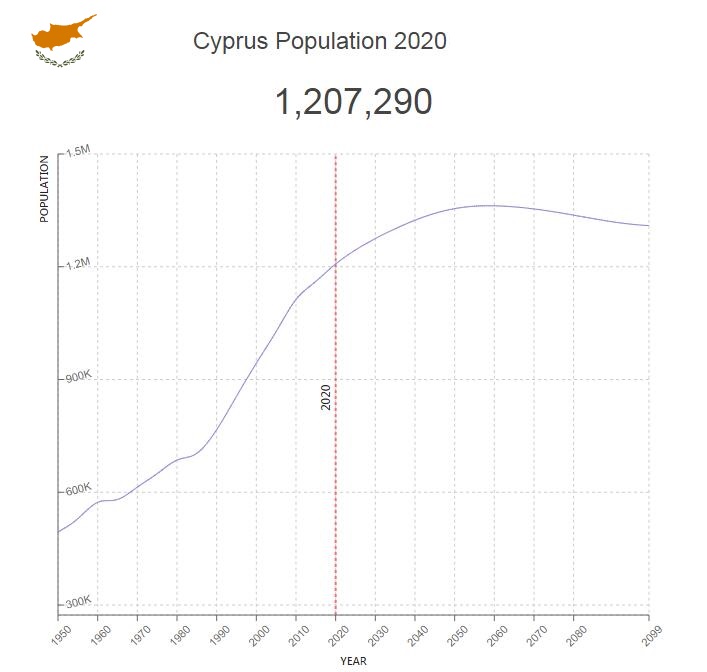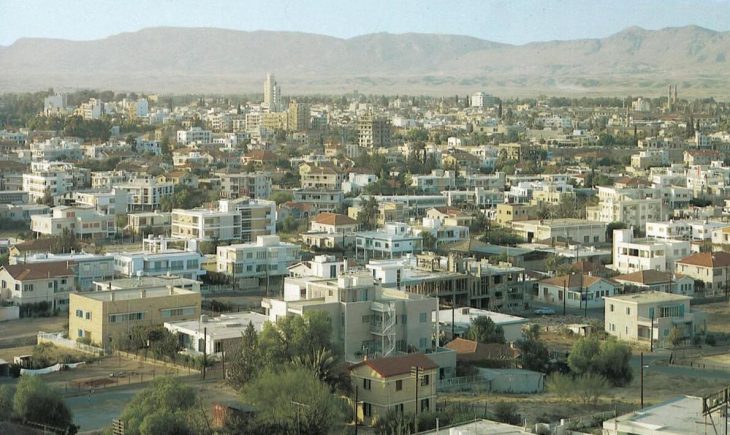Cyprus Population

Cyprus has a long history of political instability and conflict between its Greek and Turkish inhabitants, and the island has been split in two since 1974. After being severely affected by the global financial crisis in 2008, the country’s economy has finally begun to strengthen again.
Key figures and facts
- Capital: Nicosia
- Ethnic groups: Greeks 98.8%, other 1% (including Maronites, Armenians, Turkish Cypriots), unspecified 0.2%, (figures represent only the Greek Cypriot part of the island) (2011)
- Language: Greek (official) 80.9%, Turkish (official) 0.2%, English 4.1%, Romanian 2.9%, Russian 2.5%, Bulgarian 2.2%, Arabic 1.2%, Filipino 1.1%, other 4.3%, unspecified 0.6%, (figures represent only the Greek Cypriot part of the country) (2011)
- Religion: Orthodox 89.1%, Catholics 2.9%, Protestants/Anglicans 2%, Muslims 1.8%, Buddhists 1%, others (includes Maronites, Armenian Orthodox, Hindus) 1.4%, unspecified 1.1%, none/atheists 0.6% (numbers represent only the Greek Cypriot part of the island) (2011)
- Population: 1 189 085 (2018) The whole island
- Control Form: Republic
- Area: 9 250 km2
- Currency: euro
- GNP per capita: 32 708 PPP $
- National Day: October 1st
Cyprus’ Population
Cyprus has a population of 780 100 (2005). Greek Cypriots make up about 80 percent of the population, and Turkish Cypriots make up the remaining 20 percent.

Following the invasion of Turkey in 1974 and the subsequent division of the island into southern and northern Cyprus, over 200,000 Greek Cypriots had to move from the Turkish-occupied northern part and settle in the south. Northern Cyprus, which makes up 36 percent of the island’s area, has thus obtained an almost pure Turkish settlement with, among other things, 50,000 mainland Turks, and Southern Cyprus a Greek settlement.
Population of Cyprus by Year (Historical)
| Year | Population | Annual Growth Rate | Population Density | Global Rank |
| 2020 | 1,207,248 | 0.730% | 130.6666 | 158 |
| 2019 | 1,198,464 | 0.780% | 129.7159 | 158 |
| 2018 | 1,189,154 | 0.810% | 128.7083 | 158 |
| 2017 | 1,179,567 | 0.810% | 127.6708 | 158 |
| 2016 | 1,170,076 | 0.790% | 126.6436 | 158 |
| 2015 | 1,160,874 | 0.860% | 125.6477 | 158 |
| 2010 | 1,112,501 | 1.600% | 120.4125 | 156 |
| 2005 | 1,027,551 | 1.730% | 111.2188 | 155 |
| 2000 | 943,179 | 1.980% | 102.0877 | 155 |
| 1995 | 855,272 | 2.210% | 92.5739 | 155 |
| 1990 | 766,504 | 1.730% | 82.9670 | 155 |
| 1985 | 703,574 | 0.530% | 76.1564 | 156 |
| 1980 | 685,294 | 1.070% | 74.1780 | 154 |
| 1975 | 649,640 | 1.150% | 70.3194 | 152 |
| 1970 | 613,507 | 1.100% | 66.4089 | 152 |
| 1965 | 580,855 | 0.280% | 62.8751 | 150 |
| 1960 | 572,819 | 1.570% | 62.0054 | 148 |
| 1955 | 529,861 | 1.410% | 57.3563 | 148 |
| 1950 | 493,904 | 0.000% | 53.4648 | 146 |
Major Cities in Cyprus by Population
| Rank | City | Population |
| 1 | Nicosia | 200,341 |
| 2 | Limassol | 153,889 |
| 3 | Larnaca | 71,889 |
| 4 | Famagusta | 42,415 |
| 5 | Paphos | 35,850 |
| 6 | Kyrenia | 26,590 |
| 7 | Protaras | 20,119 |
| 8 | Pergamos | 14,889 |
| 9 | Morfou | 14,722 |
| 10 | Aradippou | 13,238 |
| 11 | Paralimni | 11,725 |
| 12 | Geroskipou Municipality | 8,202 |
| 13 | Lefka | 7,724 |
| 14 | Geri | 7,528 |
| 15 | Ypsonas | 7,237 |
| 16 | Dali | 5,974 |
| 17 | Tseri | 5,387 |
| 18 | Livadia | 5,218 |
| 19 | Dhromolaxia | 5,129 |
| 20 | Lapithos | 5,104 |
| 21 | Rizokarpaso | 5,104 |
| 22 | Deryneia | 5,050 |
Settlement
The largest part of the population lives in the lowlands along the coast and in the cities, which have two thirds of the population. The island’s largest city is Levkosia (Nicosia/Nicosia), which is divided into a Greek-Cypriot section and a Turkish-Cypriot section. Other important cities are the port cities of Lemesós (Limassol) and Larnax (Larnaka) on the south coast, and Gazimağusa (Famagusta) on the east coast of the Turkish-occupied zone.
Religion
About 82 percent belong to the Greek Orthodox Church, about 1.5 percent are Maronites, while Muslims make up about 16.5 percent.
Language
Greek and Turkish are official languages. English is important in teaching and trade.













































